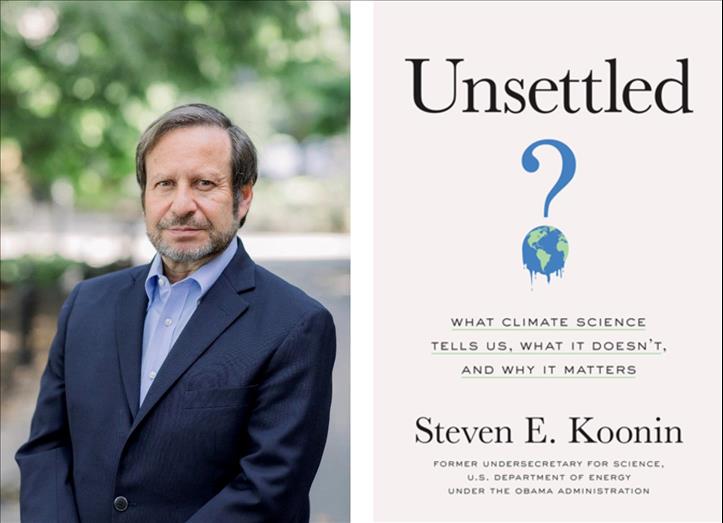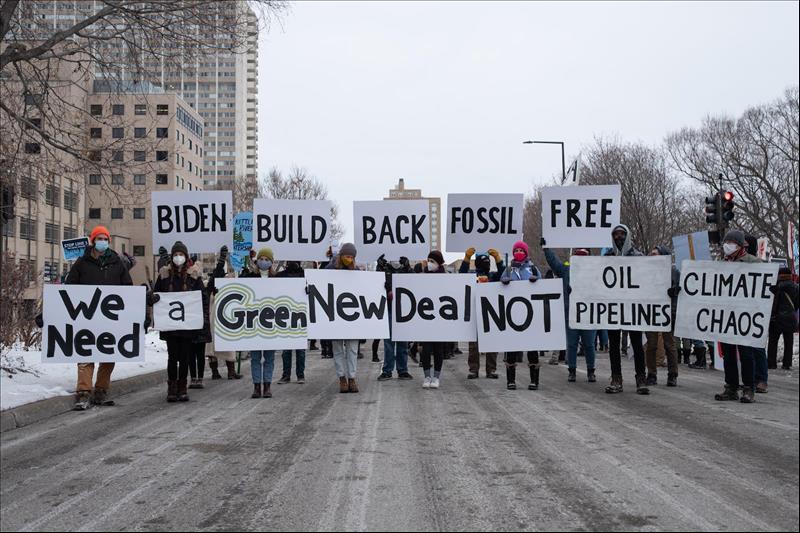(MENAFN- Asia Times) This is the first of a five-part series on climate science. Read part 1 .
Dr Steven Koonin, who served as chief scientist in the US Department of Energy during the Barack Obama administration, recently raised a furor with claims that the public has been misled about what science actually tells us about ongoing climate change. Key facts are missing from media coverage and even from summaries provided to decision-makers, he says.
According to Koonin, authoritative assessments of the UN's International Panel on Climate Change (IPCC) – the central scientific body for world climate research – provide no basis for the widely propagated notion that climate change is leading to a global catastrophe. The results published by the IPCC and the official US National Climate Assessment suggest even that global warming will only have only minor effects on the world economy.
Koonin has documented these and other claims in a just-published book,
Koonin's controversial views provide a very readable and informative introduction to the challenges of climate science, present knowledge concerning ongoing climate change and potential options for dealing with it.
In an exclusive interview for Asia Times, Koonin explains the background of the book as well as some of the unresolved issues of climate science.

Jonathan Tennenbaum : One of the most astonishing things I found in your book, Dr Koonin, is the degree of mismatch between what most of the media, politicians and NGOs are saying about the climate, on the one hand, and picture we get from scientific research, on the other.
Right up front in your introduction you give several shocking examples, which I shall just mention for the benefit of our readers.
You write: ''both the research literature and government reports that summarize and assess the state of climate science say clearly that: heatwaves in the US are now no more common than they were in 1900, and that the warmest temperatures in the US have not risen in the past fifty years.'' A few paragraphs down you add three more: ''Humans have had no detectable impact on hurricanes over the past century; Greenland's ice sheet isn''t shrinking any more rapidly today than it was eighty years ago, and the net economic impact of human-induced climate change will be minimal through at least the end of this century.''
I am sure many peoples'' first reaction will be either to reject these statements as ''fake news'', or to conclude that the media has constantly been lying to them.
Steven Koonin : I focused in the book just on points where the discrepancy is the greatest. There are other places, where the media does get it right. The globe has actually warmed by a degree over the last century and a half or so. That's not wrong. But a lot of the other things are, in fact, miscommunicated by the media and politicians.
JT : I find one of the most convincing points of the book is that you don''t put forward some kind of contrarian theory or really any theories at all. You stick to what is in the scientific publications, for the most part referencing the detailed US National Climate Assessments and the assessment reports of the UN's Intergovernmental Panel on Climate (IPCC).

Activists in St Paul, Minnesota, on January 29, 2021, hold signs calling for US President Joe Biden to support a Green New Deal and end his support of pipelines and the fossil fuel industry. Photo: Tim Evans / NurPhoto via AFP
SK : The point is the science, as expressed sometimes obscurely in the consensus reports and in the underlying data and scientific literature. In no way is this a contrarian book in that respect. It is contrarian to the stance that you get from the media and the politicians and business people who have not taken the time to actually look at what's in the reports. But of course, we will see what the pushback is over the next week as reviews start to come out. I think it's very hard to contradict what I''ve written.
I am far enough along in my career, that when the inevitable attacks come, so what? I have a penchant for trying to educate people about this very important subject. Maybe circumstances have conspired to cause me to write this book. I didn''t start out to write something like this. I''m gratified that you and many other people I''m hearing from have found it eye-opening or enlightening.
JT : Indeed. In the beginning chapters of the book, you provide a kind of initiation for lay readers into climate science and how the Earth's climate system works. I must say it is beautifully presented and has a lot of fascinating detail I had not seen elsewhere. Along the way you present that basic evidence that
(1) global warming is actually taking place, i.e. a gradual increase in the global average temperature of the atmosphere and oceans; (2) there has been a steady increase in the concentration of CO2 in the atmosphere; (3) atmospheric CO2 has a warming effect on the climate; (4) the growth of concentration of CO2 is nearly entirely a result of human activity. Similarly for methane, and so on.
But now I want to ask: Putting this together from a simple-minded standpoint, most people would conclude: Aha. So it is all true, what they are telling us – humans are to blame for global warming, and it is going to get worse unless we stop. Isn''t this the standard story? Where is the mismatch?
SK : It is when you go to the next level of questioning that issues arise. Human influences include not only greenhouse gases, but also aerosols, that are a counteracting influence. They cool. Getting the balance, understanding the balance of the sensitivity is something we are having a lot of trouble with. What is that balance like? That's one issue. Another issue is the natural variability in the system.
Anyone can see from the temperature records themselves, that the global temperature went down from 1940 to 1970, even as a CO2 and other greenhouse gases kept accumulating. So there were other things going on – in particular natural influences and internal variability of the system.

Annual global surface temperature anomalies as determined by four independent analyses. Anomalies are the deviation of temperatures from a baseline (average) value. Graphic: Courtesy of Steven Koonin
JT : Strange, I never heard it referred to in the public discussion, that there was actually a decrease in global temperature between 1940 and 1970.
SK : Really? It's right there in the IPCC, right there in the data. Also that the rate of warming from 1910 to 1940, was just about the same as the rate from 1980 to 2000, and human influences were much smaller then. I think what is happening, is that the climate system has internal modes.
The simple ones we know. For example, we know about El Nino, as it is called, that happens every five years or so, and we kind of understand it. But there are demonstrably longer-term, longer-period modes in the system, such as the Atlantic Multidecadal Oscillation, the North Atlantic Oscillation, the Pacific Decadal Oscillation, and so on. They are certainly there in the observed temperature record, but they are hard to calculate.
When you make a climate model the question is, do you have them there with the right strength, timing, and frequencies? If not, there is no reason to expect that your model is going to reproduce, at that level, what the real temperatures are.
JT : Here we get to a key issue I wanted to raise, which is the accuracy and reliability of the climate models. People put forward a lot of qualitative arguments, especially in the public domain, which make the scenario of an onrushing climate apocalypse sound plausible. But to me those qualitative arguments don''t mean much unless they are backed up by credible quantitative estimates.
It makes a difference whether I am talking about a temperature rise of half a degree, or of 15 degrees. Or a sea-level rise of a few centimeters vs one of several meters, toward the end of the century. But to distinguish between such outcomes there is really nothing to go on except observational evidence and the forecasting ability or inability of these mathematical models. So it seems like the decision-making is crucially dependent on what the models say.
SK . Right, I would agree if we would say with confidence that the warming was going to be, say, four degrees by the end of the century and if we had fair confidence in that, then we would have a very different discussion about risk values, costs and so on, than what we have currently, which is that the models really are very uncertain.
Now everybody keeps saying, yeah, but you don''t need certainty. I would argue, however, that you do need some level of certainty if you''re going to start making trillion-dollar decisions, And right now the models are all over the place and they are getting more so with each new generation of models.

Modeling of past global mean surface temperature anomalies by ten computer models of the older generation (CMIP5). The newer-generation models (CMIP6) give even more divergent results. Graphic: Wikimedia Creative Commons
JT : Indeed, one of the striking things I find in the IPCC reports and in the scientific literature, are the big discrepancies among the projections made by different climate models, for parameters such as average global temperature, average sea level and so on, to the middle of the century and beyond.
The endpoints often differ by factors of three or more. This would ordinarily make one rather skeptical about whether climate modeling is really sufficiently advanced, at this point, to qualify as a basis for political decisions
SK : You know, this is a very hard problem the climate modelers are trying to deal with. There are incomplete observations, there are feedbacks; the perturbation from human activity is only about one percent, there are multiple scales.
And so we should forgive their failings. But that does not give the modelers license to exaggerate the accuracy or precision with which they think they understand things.
Jonathan Tennenbaum received his PhD in mathematics from the University of California in 1973 at age 22. Also an author, linguist and pianist, he is a former editor of FUSION magazine. He lives in Berlin and travels frequently to Asia and elsewhere, consulting on economics, science and technology.
MENAFN09052021000159011032ID1102051535